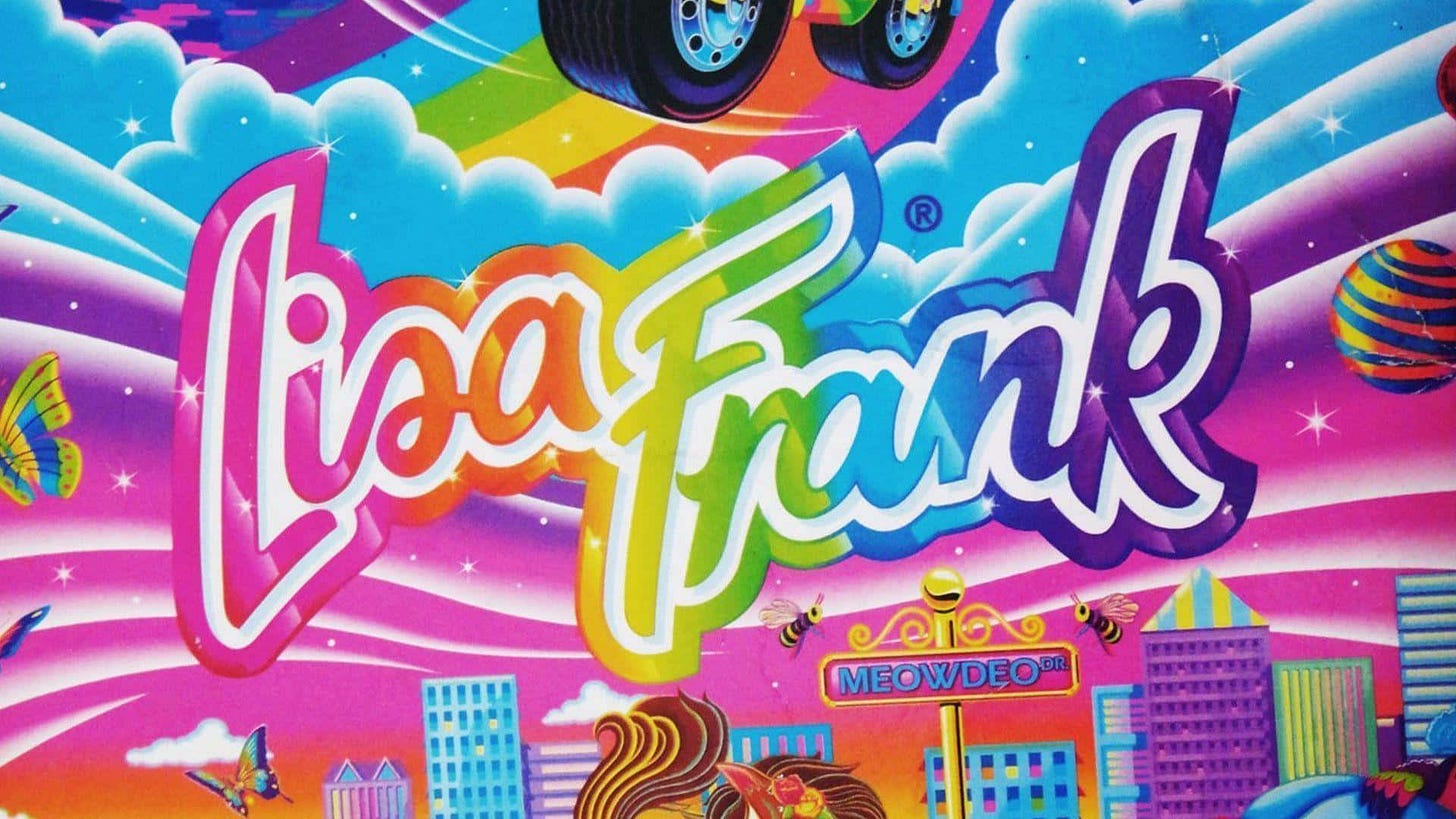Rainbow Traumatic Stress Disorder
Disturbing revelations about illustrator-mogul Lisa Frank in a new documentary.
A while ago I learned the expression “giving your power away.” Apparently it’s a gentle way to say that someone is in an abusive relationship. This phrasing attempts to put the agency back into the victim’s hands. The idea is to remind us that we have choices, even when it feels like we don’t. If we find ourselves being manipulated, we can change the terms of a relationship or even leave it entirely.
In an abusive relationship, the party with more power often consolidates financial and other resources. It can feel unthinkable for the person with less power to leave. “Taking your power back” requires a person in an abusive situation to realize that new worlds can exist outside this one bad relationship. Sometimes relationships that look very shiny on the outside secretly house these abusive dynamics.
It turns out that Lisa Frank—yes, the Lisa Frank—took a lot of people’s power away when she built her empire of school supplies and other branded items in the ‘80s and ‘90s. The list of people whom Lisa Frank has burned is long. It includes former employees, business partners and online acquaintances, her now ex-husband, and even her son.
Lisa Frank school supplies are some of the most beautifully illustrated and ubiquitous products of their kind ever to exist. A thriving resale market still circulates these items. The real-life creator of this still-beloved universe of color could behave, however, quite monstrously at times.

Glitter and Greed: The Lisa Frank Story, a four-part documentary series now streaming on Amazon, details the rise of Lisa Frank’s brand. With beginnings as an entrepreneurial college student, Lisa Frank eventually refined her products—which were conceived for a huge audience of young girls—to catapult them into massive sales and popularity. A CNN interview with Lisa Frank from 1998—it’s a rare media artifact as she is exceedingly private—mentions that she was able to charge four times the prices of her competitors. Her products—everything from backpacks to clothes, pencil cases, binders, and folders—were just that good.
With a huge array of hues and endearing details, Lisa Frank illustrations depicted color-drenched animals and other subjects such as unicorns, ice cream sundaes, and gum ball machines, all of which existed in a magical rainbow universe. Lisa Frank excelled at world-building; items such as folders often included little stories about these characters and their lives.
The products were always beautiful but they achieved a certain artistic climax around the mid-’90s. At that point, the brand had synthesized computerization with an airbrushing technique that gave the brand a sleek, psychedelic look and feel.
I belong to a Facebook group for Lisa Frank enthusiasts who buy and sell each other’s vintage finds, often for large sums of money. The group contains over 250,000 members. Items that seem to generate the most interest feature this 1990s-specific airbrushing look.
Glitter and Greed reveals that this airbrushing technique was actually the work of James Green, a former executive at Lisa Frank’s company and her now ex-husband. James had been hired by Lisa early on, and their relationship became romantic over time.
In Glitter and Greed, Lisa Frank is depicted as brilliant, paranoid, litigious, and extremely moody. She is also painted as preternaturally good at understanding and predicting the preferences of her young customers. Former employees recall their discomfort over Lisa Frank’s volatility—if she didn’t like a piece of artwork, she would shut down emotionally.
James Green is portrayed as loud, emotive, deeply controlling, exacting, and obsessive. Threatening messages to the staff from Green would remind employees to be loyal. Frank and Green employed a foreboding executive named Rhonda—the film’s most unsettling participant and the bearer of the nickname “The Enforcer”—to carry out frequent, seemingly retaliatory firings.
For all his other qualities, James Green did create the airbrushing technique that makes Lisa Frank products look so unique and beautiful even today. He also refined Lisa Frank’s creative marketing practices and managed the company’s day-to-day operations. It may have been Lisa Frank’s name and concept, but Green took her products to the next level.
Watching Glitter and Greed, you become aware that the one person who could bully Lisa Frank herself was James Green. She was obviously in love with him and I’m sure that clouded her judgment–she gave Green 49% of the company for their wedding.
I have been a Lisa Frank fan since kindergarten and like many people, I have always been intrigued by the elusive person behind the brand. It was amazing to see footage from her wedding in Glitter and Greed. During the ceremony, Lisa Frank emerges from a horse-drawn carriage in a poofy white dress with rainbow-colored flower accents. The nostalgia I felt watching her would be impossible to articulate. That is our Lisa Frank, creator of a universe that many of us love and still believe is real—and she really does love rainbows!
Lisa Frank created a style so iconic that it basically became nostalgic as soon as it entered the market. This ‘90s sweater featuring kittens is listed on eBay for $2,000.
At his wedding, James Green seems as hyper-controlling there as he is in the office. He micromanages and curates the photographs and video in real time. He makes off-color comments. Lisa Frank laughs uncomfortably.
Green freely admits that he took Lisa Frank’s power away at the company, without even asking her. Their eventual divorce was cataclysmic, requiring litigation to sort out their power struggle over the company. Lisa Frank won in the end, and James Green was forced to sell his shares to her. Their sons Forest and Hunter—named after shades of green—also took sides. Each parent left with one son. The son who sided with his father tells viewers that he could envision his mother suing him.
Now James Green lives in Mexico by the beach. He owns a bar. In the documentary he wears a t-shirt that says, “I work my art to death.” He seems utterly broken by his experience. “I am Lisa Frank,” he states unequivocally. He has clearly mellowed out—he is somewhat reflective about his toxic managerial tendencies and thankful for his former employees—but he rambles on about cocaine and comes across as lost. He has not learned the one important lesson of cutting ties with a litigious bully: Stop negotiating, cut your losses, and move on.
How does he feel about his marriage to Lisa Frank? “It was a bad business decision.” Did he get down on one knee to propose? He’s “just not that type of guy”—a line which made me laugh out loud. Incidentally, he tells us, her engagement ring was huge.
Lisa Frank out-maneuvered James Green, but not without creating lasting damage. Many of her former employees—also artists—view their experiences as similarly traumatic.
One employee states that he had “Rainbow Traumatic Stress Disorder.” Another says he was suicidal. Across the board, former employees describe having their power taken away by both Lisa Frank and James Green. Lisa Frank sued one employee who left for a company that was barely even a competitor. Within the workplace culture, disparities were outrageous. Lisa Frank made so much money that she bought a private jet, while employees recount living off food stamps.
Common threads emerge from these stories. We hear about these employees’ childhoods, with parents who often discouraged their interest in art and told them they would never financially survive.
Abusers are attracted to people who haven’t discovered their own sense of inner worth. The converse is also true. There was clearly something that kept these employees in Lisa Frank’s abusive clutches, at times for years.
One employee says, “It was like having a parent that you wanted to please.” Another line: “I was the type of person and personality that it…worked on.” Unconsciously, perhaps, these employees were replaying old dynamics with Lisa Frank and James Green, an unwitting new set of nightmarish, invalidating “parents.”
When you leave an abusive relationship, you wake up to the reality of how you’ve been treated. “Taking your power back” may involve noise and even violence. One employee offered to fight James Green in the parking lot. So much for unicorns and rainbows!
Her former employees do genuinely seem awed at Lisa Frank’s brilliance, both as an artist and as an entrepreneur. People enjoy proximity to greatness, and Lisa Frank achieved something amazing: She made real money as an artist, and she created things of lasting value. The greatness that people saw in Lisa Frank was probably at some level the untapped greatness inside themselves.
“We put our heart and soul into those little guys,” one former employee says about her illustrations for the company. “The unicorns, leopards and all those characters came out of love. I just want them to live forever.”
Lisa Frank has been out of the limelight for the last twenty years or so, but she’s stayed busy. She plagiarized a penniless social media influencer, and she preyed upon the inexperienced founders of a cosmetics brand that attempted to partner with her. One of the brand’s co-founders quips, “I was, like, getting bullied by Lisa Frank. Put that on my tombstone.”
It feels unfair that Lisa Frank has gotten away with so much. Maybe it’s possible, though, that the punishment for being Lisa Frank…is being Lisa Frank. To be a person who is so greedy, so litigious, that she would even sue loved ones, can’t feel very good. It is the thief who always believes he is being stolen from—or she, in this case.
One employee reflects, “Lisa kind of got what she deserves, in a way.” Her brand should have been bigger. It should have continued growing and transforming, and instead it sort of faded away.
Things sometimes get lost when you’re bringing something extraordinarily beautiful into reality. Whatever you want to say about Lisa Frank, she was able to show children of all ages a universe where things were happier and prettier than they are here.
Her resale market speaks volumes. Whether you are trying to reclaim something from childhood that you once had and lost, or you’re attempting to get something you never had to begin with, the process of obtaining those things now is extraordinarily costly.
There is one place that I’ve heard described as “like Lisa Frank, but real life.” That place is Tokyo, Japan. I visited once and completely fell in love. It’s true–the color scheme there feels otherworldly, as if it belongs to a more beautiful universe.
A popular tourist destination there is the Tokyo Robot Restaurant’s cabaret show, a psychedelic spectacle featuring “robots” in glowing costumes. In moments the show—and its multicolored, metallic venue—are beautiful. Yet it’s also chaotic and noisy. Your heels stick to the floor from dried beer. The only thing worse than the long line to the bathroom is the state of the bathroom itself.
I sometimes wish that I could live inside Lisa Frank’s world. For now, looking at these objects from afar will have to do.
I advise clients across industries on a broad array of writing and career projects. If I feel right for you, visit my business website to learn more and to book a session.
Doing Dry January in NYC? Attend Carla Tanz’s Dry January yoga classes Fridays at Flok & Five Pillars Yoga.








I never heard of her before, but recognized the work. Great story...love the audible!